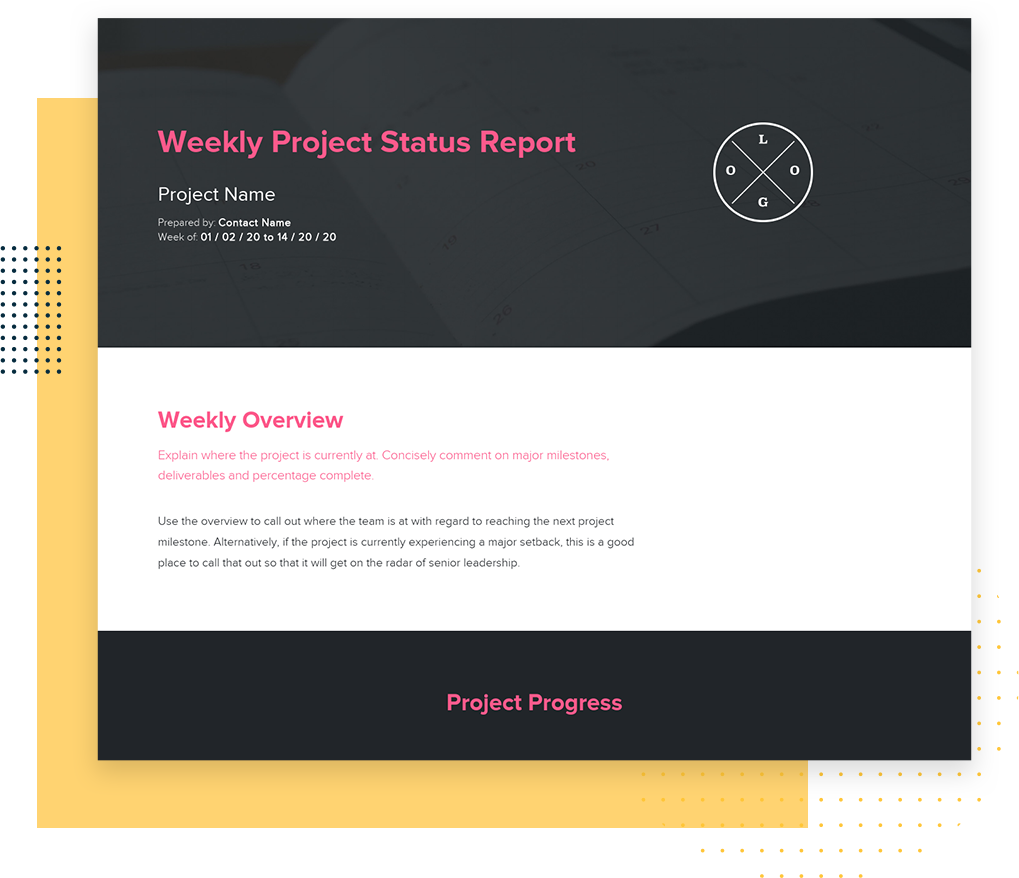
Use the weekly project status report template to document the current state of your project. Keep stakeholders informed with timely and relevant information about a project’s progress and any roadblocks that may lie ahead.
Xtensio is your team space for beautiful living documents.
Create, manage and share business collateral, easily.
Join the 277,871 changemakers.
Xtensio is your team space for beautiful living documents.
Create, manage and share business collateral, easily.
Join the 277,871 changemakers.
A weekly project status report documents the current state of a major project. With this tool, you can organize and manage your team’s weekly schedule and keep stakeholders informed with timely and relevant information about a project’s progress and any roadblocks that may lie ahead. Use the project status report template to:
A project status report is a brief snapshot of where things are at with a project. Project status reports are used to give clients and stakeholders status updates and should include information that helps keep the project on track. Regular weekly reporting on the project’s progress helps you outline your team’s workload, timeline, business-critical efforts and risks. Plus, the status report is a great way to uncover opportunities for improving efficiency.
While monthly and quarterly reports give a bird’s-eye view of your project’s progress and vision, project managers use weekly project status reports to maintain an ongoing report of updates and stats as they happen instantly. The beauty of a weekly report should be that it can be ready within the hour if a client requests it.
Ongoing reports will help:
The most important thing that the project status report template can help with is ensuring that the project team gets the work done. Reporting is important in project management and Xtensio’s free status report template makes it easy to keep track of productivity, roadblocks and deadlines.
In project management, the status progress report should include any and all information that communicates your team’s weekly tasks and goals. Xtensio’s project status report template is formatted to help you outline your reports concisely so everyone can clearly understand important milestones, action items and issues.
Generally, you’ll need to include these things in your project status report:
Optional items to include in your project report:
It’s important to note that the structure of your status report should be clear and direct, while also engaging. No one wants to read a dry report or requirements doc! Using Xtensio’s project status template will definitely help.
Begin by introducing yourself and your project. Include the project’s name, your name, and the date. You should also offer a concise review of where the team is in terms of meeting the next project milestone.
The main portion of your progress report should detail where your team is at this week with the project.
Save the project status report template to make it your own.
Add images, videos, charts/graphs, or lists and forms to make sure your weekly reports are visually engaging. Update color schemes, change background colors and add your own logo to match your (or a client’s) branding. The templates that we have are fully customizable to match your needs.
Your project status reports are meant to be shared. Remember, the goal is to provide timely updates that keep your team on track towards completing important milestones and deliverables for your projects. With Xtensio you can add important stakeholders to collaborate on your project status reports and share the live link with the whole team so everyone is always in sync.
Status reports, like any other document, must be personalized for your audience. For instance, a client has different expectations from the status report than your internal team. You can create your weekly status report, duplicate and adjust your reporting based on who you’re communicating with. There are a few things to keep in mind depending on whether you’re creating your report for internal or external usage.
External Status Reports:
You’re talking to a client, an investor or another key stakeholder outside of your organization. Keep that in mind when writing your report. The tone should be professional and typically oriented around high-level goals for the project at hand. Proofreading and branding are important when sending these external reports. External reports should also outline any information, approvals or roadblocks that need to be cleared from their end in order for your team to move forward with the project.
Internal Status Reports:
These project reports are more casual. Bring up any internal roadblocks, looming deadlines you’re worried about missing, or other difficulties concerning your team’s work here. It is critical to be open and honest with your staff.
On the same token, enthusiasm and support go a long way. Congratulate your team on solving that tricky technical issue that the client would never even know about, and celebrate important milestones as a way of keeping the momentum going. Internal reports will also be more detail-oriented with a focus on items that are of value to your team.